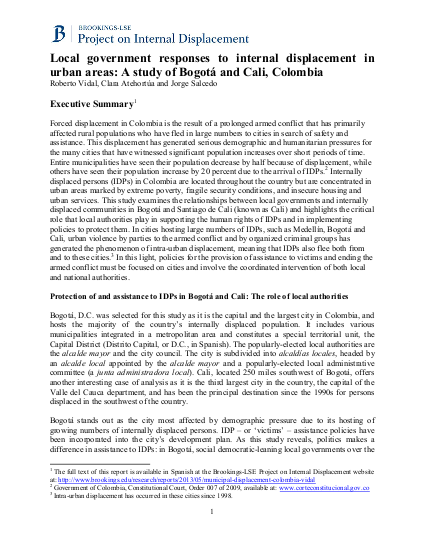
Forced displacement in Colombia is the result of a prolonged armed conflict that has primarily affected rural populations who have fled in large numbers to cities in search of safety and assistance. This displacement has generated serious demographic and humanitarian pressures for the many cities that have witnessed significant population increases over short periods of time. Entire municipalities have seen their population decrease by half because of displacement, while others have seen their population increase by 20 percent due to the arrival of IDPs.2 Internally displaced persons (IDPs) in Colombia are located throughout the country but are concentrated in urban areas marked by extreme poverty, fragile security conditions, and insecure housing and urban services. This study examines the relationships between local governments and internally displaced communities in Bogotá and Santiago de Cali (known as Cali) and highlights the critical role that local authorities play in supporting the human rights of IDPs and in implementing policies to protect them. In cities hosting large numbers of IDPs, such as Medellín, Bogotá and Cali, urban violence by parties to the armed conflict and by organized criminal groups has generated the phenomenon of intra-urban displacement, meaning that IDPs also flee both from and to these cities.3 In this light, policies for the provision of assistance to victims and ending the armed conflict must be focused on cities and involve the coordinated intervention of both local and national authorities.
Resource collections
- UN Habitat - Urban Response Collection
- Urban Response - Urban Crisis Preparedness and Risk Reduction
- Urban Response Collection - Community Engagement and Social Cohesion
- Urban Response Collection - Economic Recovery
- Urban Response Collection - Environment and Climate Change
- Urban Response Collection - Housing, Land and Property
- Urban Response Collection - Urban Crisis Response, Recovery and Reconstruction
- Urban Response Collection - Urban Resilience